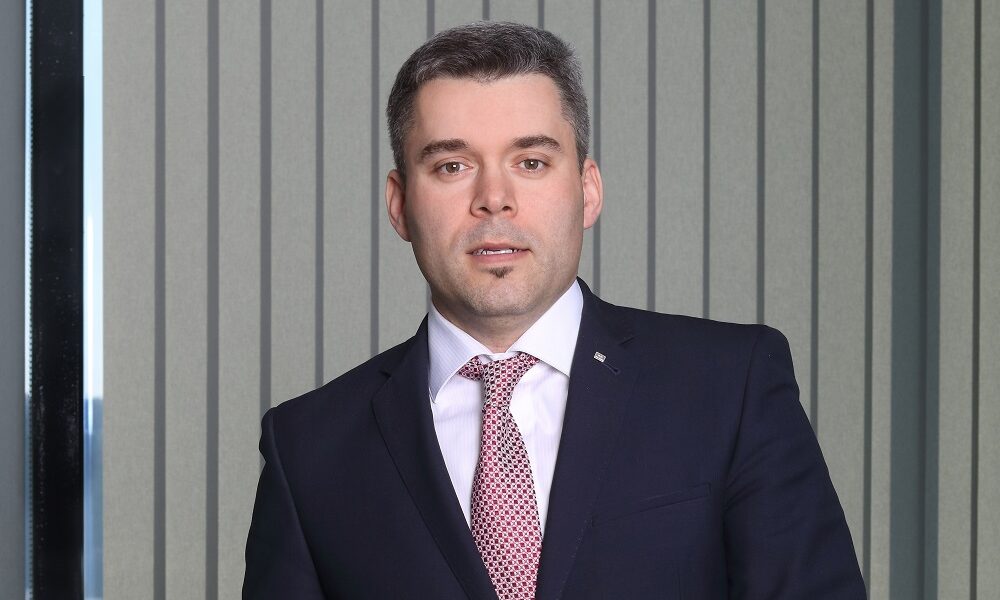Ing. Tomáš Tóth graduated in Transport Engineering at the University of Pardubice and held several managerial positions in the ČD Group. He has been with ČD Cargo a.s. since 2013 and is currently Chairman of the Board of Directors of the largest Czech rail freight carrier.
You have been operating as a subsidiary of České dráhy since 2007. What is your mission?
As the name of our company implies, our primary task is to ensure the transport of goods by rail. We transport more than 60 million tonnes of goods annually. Not only do we transport bulk substrates, but our trains also carry metallurgical products, fuel, agricultural products, newly manufactured cars, etc. We make a signifi cant contribution to the eradication of the consequences of the bark beetle calamity that hit our forests. Our slogan “Anything – Anywhere” is well-known, and its truthfulness is demonstrated, for example, by the transport of extraordinary shipments – train sets for the metro system, spent nuclear fuel containers, humanitarian goods, and military equipment.
You have managed to make the company profitable again in 2021. Can you tell us something about it?
The year 2021 was marked by growth in transport volumes and revenues in most of the key commodities, with the exception of automotive and combined transport, which were, however, hampered by a number of external infl uences. Our company made a profi t before tax under the International Accounting Standards (IFRS) of EUR 290 million for 2021. This is a year-on-year improvement of CZK 674 million. However, there is no need for a big pat on the back; the end of last year already clearly indicated that 2022 would be marked by a sharp rise in input cost prices and continued shortages of certain components in industrial production. More recently, the war confl ict in Ukraine has signifi cantly impacted the macroeconomic situation and, with it, a change in some commodity fl ows. Last year’s results are, therefore, left to the statisticians.

In a globalised economy, the transport of goods plays a vital role. What is your territorial scope, and are you considering expansion?
That is a good question. The Czech Republic is really small for us. Apart from the Czech Republic, we are authorised to operate rail freight transport in six other European countries. We fi rst started developing our activities in Poland in 2015. Today, we transport around 4 million tonnes of goods annually in the Polish market. The purchase of new Vectron interoperable locomotives has enabled us to “look west” as well, first to Austria in 2019 and to Germany a year later. Thanks to the cooperation between the two foreign branches, ČD Cargo can offer a transit route not only through Slovakia and the Czech Republic but also along the corridor line through Austria and Passau on to Germany. This is particularly important at this time, given the significantly reduced capacity of the Děčín-Bad Schandau border crossing. Further expansion was directed eastwards and towards the Balkans. As a result, a “licence” was obtained in Slovakia (June 2020), Hungary (October 2020) and Croatia (April 2022). Here we do not need to deploy the latest technology but can use older but still fully operational and reliable locomotives. We consider the Balkans in general to be a very promising market, so we have already applied for a licence in Slovenia, and we want to establish a subsidiary in Serbia. Other Western European markets are not uninteresting either, specifically the Benelux countries, for example. In connection with the change in the geopolitical situation, there are also changes in the flow of goods. Our customers are looking for alternative sources of raw materials, for which new routes have to be secured. For example, shipments to and from Baltic or Adriatic ports are growing signifi cantly. Thanks to our wide territorial coverage, we can fully cover the requirements of our trading partners.
Rail freight transport is a tool of the green policy of the Czech Republic. What can we imagine under this, and what kind of ecological drives do you want to apply?
It is important to remember that green policy is not just about new vehicle propulsion, as rail use is by its very nature a green policy tool. Why? It is environmentally friendly and sustainable, makes maximum use of electricity with lower noise and harmful exhaust emissions, and accounts for only 0.4 – 0.5% of the EU’s greenhouse gas emissions from transport – while all transport in the EU accounts for 25% of the Union’s total emissions. It is also more energy-efficient than road transport, using nine times less electricity than electric vehicles for the same power. In contrast, rail uses only 1/3 of the diesel for the same power. And, last but not least, it is safe. Our trains use 92% electric power. We are gradually modernising our fleet of diesel locomotives and fitting them with new engines that meet strict emission limits. And, of course, we count on hybrid or battery solutions in the near future.

How do you think it is possible to get goods from road to rail?
Primarily, we must keep goods on the railways; conditions for rail transport must not deteriorate. And as far as the transfer of goods is concerned, I see the biggest opportunity in the cooperation of transport modes. While today we compete with the road, in the future, I see cooperation and taking advantage of the advantages of road and rail as the only sustainable option. Rail offers fast and environmentally friendly transportation over longer distances. At the same time, the advantage of the road is flexibility and efficient first/last mile operation. All this without reloading goods, using intermodal units.
Thank you for the interview.




